Taehan Kim
VocalAgent: Large Language Models for Vocal Health Diagnostics with Safety-Aware Evaluation
May 19, 2025Abstract:Vocal health plays a crucial role in peoples' lives, significantly impacting their communicative abilities and interactions. However, despite the global prevalence of voice disorders, many lack access to convenient diagnosis and treatment. This paper introduces VocalAgent, an audio large language model (LLM) to address these challenges through vocal health diagnosis. We leverage Qwen-Audio-Chat fine-tuned on three datasets collected in-situ from hospital patients, and present a multifaceted evaluation framework encompassing a safety assessment to mitigate diagnostic biases, cross-lingual performance analysis, and modality ablation studies. VocalAgent demonstrates superior accuracy on voice disorder classification compared to state-of-the-art baselines. Its LLM-based method offers a scalable solution for broader adoption of health diagnostics, while underscoring the importance of ethical and technical validation.
Pesti-Gen: Unleashing a Generative Molecule Approach for Toxicity Aware Pesticide Design
Jan 24, 2025Abstract:Global climate change has reduced crop resilience and pesticide efficacy, making reliance on synthetic pesticides inevitable, even though their widespread use poses significant health and environmental risks. While these pesticides remain a key tool in pest management, previous machine-learning applications in pesticide and agriculture have focused on classification or regression, leaving the fundamental challenge of generating new molecular structures or designing novel candidates unaddressed. In this paper, we propose Pesti-Gen, a novel generative model based on variational auto-encoders, designed to create pesticide candidates with optimized properties for the first time. Specifically, Pesti-Gen leverages a two-stage learning process: an initial pre-training phase that captures a generalized chemical structure representation, followed by a fine-tuning stage that incorporates toxicity-specific information. The model simultaneously optimizes over multiple toxicity metrics, such as (1) livestock toxicity and (2) aqua toxicity to generate environmentally friendly pesticide candidates. Notably, Pesti-Gen achieves approximately 68\% structural validity in generating new molecular structures, demonstrating the model's effectiveness in producing optimized and feasible pesticide candidates, thereby providing a new way for safer and more sustainable pest management solutions.
Private Yet Social: How LLM Chatbots Support and Challenge Eating Disorder Recovery
Dec 16, 2024Abstract:Eating disorders (ED) are complex mental health conditions that require long-term management and support. Recent advancements in large language model (LLM)-based chatbots offer the potential to assist individuals in receiving immediate support. Yet, concerns remain about their reliability and safety in sensitive contexts such as ED. We explore the opportunities and potential harms of using LLM-based chatbots for ED recovery. We observe the interactions between 26 participants with ED and an LLM-based chatbot, WellnessBot, designed to support ED recovery, over 10 days. We discovered that our participants have felt empowered in recovery by discussing ED-related stories with the chatbot, which served as a personal yet social avenue. However, we also identified harmful chatbot responses, especially concerning individuals with ED, that went unnoticed partly due to participants' unquestioning trust in the chatbot's reliability. Based on these findings, we provide design implications for safe and effective LLM-based interventions in ED management.
Separate and Reconstruct: Asymmetric Encoder-Decoder for Speech Separation
Jun 10, 2024Abstract:Since the success of a time-domain speech separation, further improvements have been made by expanding the length and channel of a feature sequence to increase the amount of computation. When temporally expanded to a long sequence, the feature is segmented into chunks as a dual-path model in most studies of speech separation. In particular, it is common for the process of separating features corresponding to each speaker to be located in the final stage of the network. However, it is more advantageous and intuitive to proactively expand the feature sequence to include the number of speakers as an extra dimension. In this paper, we present an asymmetric strategy in which the encoder and decoder are partitioned to perform distinct processing in separation tasks. The encoder analyzes features, and the output of the encoder is split into the number of speakers to be separated. The separated sequences are then reconstructed by the weight-shared decoder, as Siamese network, in addition to cross-speaker processing. By using the Siamese network in the decoder, without using speaker information, the network directly learns to discriminate the features using a separation objective. With a common split layer, intermediate encoder features for skip connections are also split for the reconstruction decoder based on the U-Net structure. In addition, instead of segmenting the feature into chunks as dual-path, we design global and local Transformer blocks to directly process long sequences. The experimental results demonstrated that this separation-and-reconstruction framework is effective and that the combination of proposed global and local Transformer can sufficiently replace the role of inter- and intra-chunk processing in dual-path structure. Finally, the presented model including both of these achieved state-of-the-art performance with less computation than before in various benchmark datasets.
A Knowledge-Component-Based Methodology for Evaluating AI Assistants
Jun 09, 2024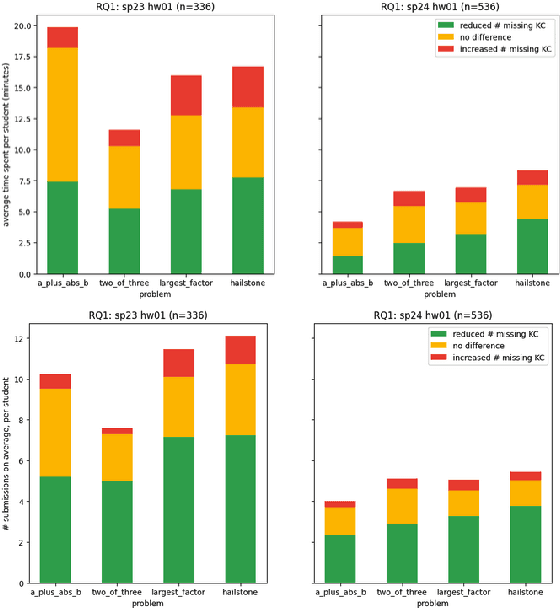
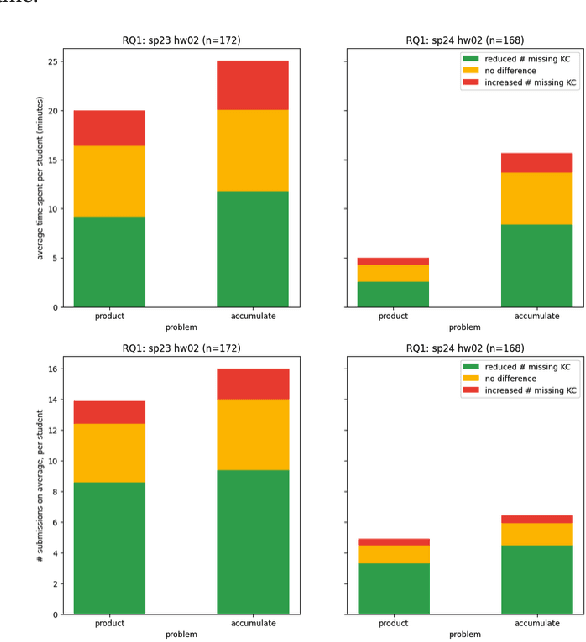
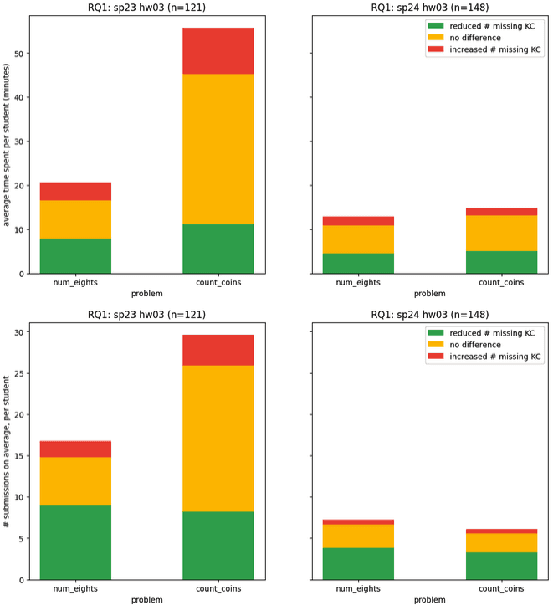
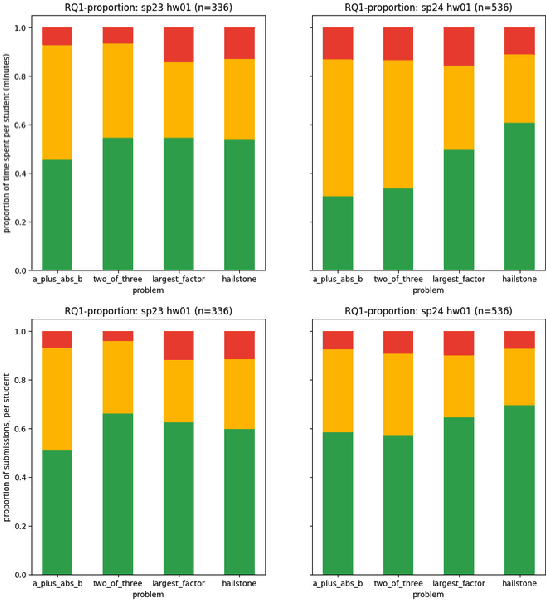
Abstract:We evaluate an automatic hint generator for CS1 programming assignments powered by GPT-4, a large language model. This system provides natural language guidance about how students can improve their incorrect solutions to short programming exercises. A hint can be requested each time a student fails a test case. Our evaluation addresses three Research Questions: RQ1: Do the hints help students improve their code? RQ2: How effectively do the hints capture problems in student code? RQ3: Are the issues that students resolve the same as the issues addressed in the hints? To address these research questions quantitatively, we identified a set of fine-grained knowledge components and determined which ones apply to each exercise, incorrect solution, and generated hint. Comparing data from two large CS1 offerings, we found that access to the hints helps students to address problems with their code more quickly, that hints are able to consistently capture the most pressing errors in students' code, and that hints that address a few issues at once rather than a single bug are more likely to lead to direct student progress.
Diffusion-EDFs: Bi-equivariant Denoising Generative Modeling on SE(3) for Visual Robotic Manipulation
Sep 07, 2023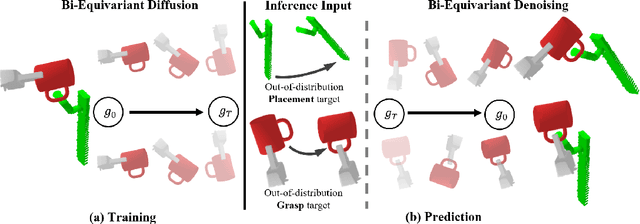



Abstract:Recent studies have verified that equivariant methods can significantly improve the data efficiency, generalizability, and robustness in robot learning. Meanwhile, denoising diffusion-based generative modeling has recently gained significant attention as a promising approach for robotic manipulation learning from demonstrations with stochastic behaviors. In this paper, we present Diffusion-EDFs, a novel approach that incorporates spatial roto-translation equivariance, i.e., SE(3)-equivariance to diffusion generative modeling. By integrating SE(3)-equivariance into our model architectures, we demonstrate that our proposed method exhibits remarkable data efficiency, requiring only 5 to 10 task demonstrations for effective end-to-end training. Furthermore, our approach showcases superior generalizability compared to previous diffusion-based manipulation methods.
 Add to Chrome
Add to Chrome Add to Firefox
Add to Firefox Add to Edge
Add to Edge